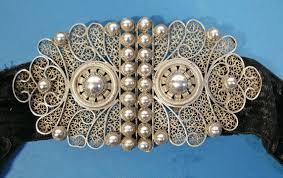‘Bruneren’: the polishing of a metal by friction with a highly polished agate, hematite stone or highly polished steel (no abrasive). This makes the surface harder and shining.
Engraving: lines, cut out of the surface with a V-shaped burin
Etching: protect the surface with a soft material (wax, varnish), draw lines and patterns in it, let it in an acid bath that corrodes those lines in the metal.
Enameling: a low melting glass type is fused to the metal (as in ceramics).
Basic enamel is called frit and is translucent blue - green. Glass has a higher melting point than metal. In order to reduce the melting point to 700° and 850° red lead is added to the standard recipe for glass. Frit includes fused silica, sodium- or potassium carbonate, and red lead.
In order to color metal oxides are added as a pigment. Which also determine the coefficient of expansion which must be as far as possible equal to that of the metal. Otherwise enamel jumps off there by contraction and expansion differences. Copper oxide gives turquoise or yellow-green, antimony oxide yellow, iron oxide red, and manganese oxide purple. In order to make it opaque tin oxide may be included, giving a white enamel in combination with arsenic trioxide. The final color is also dependent on temperature and the removal or introduction of oxygen.
The enamel is pulverized, the metal cleaned with acid, painted and dried. Sometimes it is necessary to paint both sides. This counter -enamel raises tension between metal and the enamel on the other side.
Enamel cloisonné: color planes are separated by thin metal strip or wire.
Enamel enfoncé: enamel is applied topically in recessed metal parts
Enamel champlevé: enamel is in etched or cut lines and patterns
Enamel fenêtré: in a wire mesh is baked enamel (on removable film) so that it is translucent as a window.
Enamel peint (ure): enamel painted directly on the metal.
Granulation: tiny metal balls fixate on the workpiece. The Etruscans decorated already objects with gold granules. Put copper oxide and starch, and then granules on the workpiece. Let it dry and then gently heat it in its entirety. The carbon contained in the starch is a reducing agent by which the copper oxide is converted into copper. Due to the contact with a gold particles eutectic forms: an alloy having a lower melting point than that of the constituent parts. Scraps of gold were therefore heated with charcoal powder, so they could not coalesce but were gems.
 Filigree (filigrann) decoration with fine (precious) metal. Latin filum and granum: a thread of beads.
Filigree (filigrann) decoration with fine (precious) metal. Latin filum and granum: a thread of beads.
Both techniques are soldered with solder (powder)!
